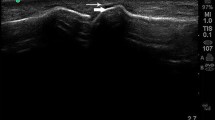Abstract
Objective
Dual-energy CT (DECT) is being widely used in suspected gout patients in recent years. Many clinicians tend to use DECT instead of aspiration biopsy in the diagnosis of gout, but its accuracy has shown controversial results. In this systematic review and meta-analysis, we sought to evaluate the accuracy of DECT in the diagnosis of gout.
Materials and methods
We performed a systematic review of the literature published in Medline, Embase, PubMed, and Cochrane databases. Studies included are all clinical trials of DECT in the diagnosis of gout. Quality assessment of bias and applicability was conducted using the Quality of Diagnostic Accuracy Studies-2 (QUADAS-2). We recorded sensitivity and specificity of algorithms and calculated positive likelihood ratio (PLR), negative likelihood ratio (NLR) and diagnostic odd ratio (DOR), and respective confidence intervals (CI). The summary receiver operating characteristic curve (sROC) was drawn to get the Cochran Q-index and the area under the curve (AUC).
Results
Seven studies were included in this review and showed high homogeneity. The analysis results presented the pooled sensitivity was 88% (95% CI 84–90%) and specificity was 90% (95% CI 85–93%). Then, we figured out that the pooled PLR was 8.48 (95% CI 5.89–12.22) and NLR was 0.10 (95% CI 0.04–0.24) respectively. In addition, Cochran-Q was 0.90 and AUC was 0.9565 in sROC curve.
Conclusions
DECT showed relatively high sensitivity and specificity in the diagnosis of gout. Synthetically considering these DECT abnormalities could improve the diagnostic sensitivity. More rigorous and standardized studies are still needed to support these findings.





Similar content being viewed by others
References
Ankli B. Current epidemiology of gout. Therapeutische Umschau Revue therapeutique. 2016;73(3):125–9.
Rai SK, Burns LC, De Vera MA, Haji A, Giustini D, Choi HK. The economic burden of gout: a systematic review. Semin Arthritis Rheum. 2015;45(1):75–80.
Diagnosis UM. Management of gout. BMJ. 2006;332(7553):1315–9.
Cheng J, Abdi S. Complications of joint, tendon, and muscle injections. Techniques in regional anesthesia & pain management. 2007;11(3):141–7.
Swan A, Amer H, Dieppe P. The value of synovial fluid assays in the diagnosis of joint disease: a literature survey. Ann Rheum Dis. 2002;61(6):493–8.
Nicolaou S, Yong-Hing CJ, Galea-Soler S, Hou DJ, Louis L, Munk P, et al. As a potential new diagnostic tool in the management of gout in the acute setting. AJR Am J Roentgenol. 2010;194(4):1072–8.
Monu JU, Pope TL Jr. Gout: a clinical and radiologic review. Radiol Clin N Am. 2004;42:169–84.
Mileto A, Marin D. Dual-energy computed tomography in genitourinary imaging. Radiol Clin N Am. 2017;55(2):373–91.
Mileto A, Marin D, Nelson RC, Ascenti G, Boll DT. Dual-energy MDCT assessment of renal lesions: an overview. Eur Radiol. 2014;24(2):353–62.
Coursey CA, Nelson RC, Boll DT, et al. Dual-energy multidetector CT: how does it work, what can it tell us, and when can we use it in abdominopelvic imaging? Radiographics: a review publication of the Radiological Society of North America, Inc. 2010;30(4):1037–55.
Marin D, Boll DT, Mileto A, Nelson RC. State of the art: dual-energy CT of the abdomen. Radiology. 2014;271(2):327–42.
Metzger SC, Koehm M, Wichmann JL, et al. Dual-energy CT in patients with suspected gouty arthritis: effects on treatment regimen and clinical outcome. Acad Radiol. 2016;23(3):267–72.
Baer AN, Kurano T, Thakur UJ, et al. Dual-energy computed tomography has limited sensitivity for non-tophaceous gout: a comparison study with tophaceous gout. BMC Musculoskelet Disord. 2016;17:91.
Whiting PF, Rutjes AW, Westwood ME, et al. QUADAS-2: a revised tool for the quality assessment of diagnostic accuracy studies. Ann Intern Med. 2011;155(8):529–36.
Bongartz T, Glazebrook KN, Kavros SJ, et al. Dual-energy CT for the diagnosis of gout: an accuracy and diagnostic yield study. Ann Rheum Dis. 2015;74:1072–7.
Hu HJ, Liao MY, Xu LY. Clinical utility of dual-energy CT for gout diagnosis. Clin Imaging. 2015;39(5):880–5.
Wu H, Xue J, Ye L, Zhou Q, Shi D, Xu R. The application of dual-energy computed tomography in the diagnosis of acute gouty arthritis. Clin Rheumatol. 2014;33(7):975–9.
Choi HK, Burns LC, Shojania K, et al. Dual energy CT in gout: a prospective validation study. Ann Rheum Dis. 2012;71(9):1466–71.
Glazebrook KN, Guimaraes LS, Murthy NS, et al. Identification of intraarticular and periarticular uric acid crystals with dual-energy CT: initial evaluation. Radiology. 2011;261(2):516–24.
Liu W, Xue HD, Zeng XJ, et al. Application of dual-energy computed tomography for detecting uric acid deposition in patients with gout. Acta Academiae Medicinae Sinicae. 2010;32(6):645–8.
Ren J, Zhou Y, Wu H, Zhu L, Cai X. Value of dual-energy computed tomography in the diagnosis of gouty arthritis. Journal of Southern Medical University. 2015;35(3):384–6.
Wallace SL, Robinson H, Masi AT, Decker JL, McCarty DJ, Yü TF. Preliminary criteria for the classification of the acute arthritis of primary gout. Arthritis Rheum. 1977;20(3):895–900.
So A, Busso N. Update on gout 2012. Joint Bone Spine. 2012;79(6):539–43.
Durcan L, Grainger R, Keen HI, Taylor WJ, Dalbeth N. Imaging as a potential outcome measure in gout studies: a systematic literature review. Semin Arthritis Rheum. 2016;45(5):570–9.
Ponka D, Baddar F. Joint aspiration. Canadian family physician Medecin de famille canadien. 2013;59(7):747.
Newberry SJ, Fitz Gerald JD, Motala A, et al. Diagnosis of gout: a systematic review in support of an American College of Physicians Clinical Practice Guideline. Ann Intern Med. 2017;166(1):27–36.
Author information
Authors and Affiliations
Corresponding authors
Ethics declarations
Competing interests
The authors declare that they have no competing interests.
Additional information
Zhange Yu, Tianli Mao, Yaping Xu, Tengqi Li, and Yanhua Wang joint first authors.
Elegy: Zhange Yu, MD. had done a major work for this study. Unfortunately, he passed away peacefully on 17 May 2017, and he was only early 30s. We will miss him forever. We believe he will still keep shined in the heaven. God bless him!
Rights and permissions
About this article
Cite this article
Yu, Z., Mao, T., Xu, Y. et al. Diagnostic accuracy of dual-energy CT in gout: a systematic review and meta-analysis. Skeletal Radiol 47, 1587–1593 (2018). https://doi.org/10.1007/s00256-018-2948-y
Received:
Revised:
Accepted:
Published:
Issue Date:
DOI: https://doi.org/10.1007/s00256-018-2948-y




